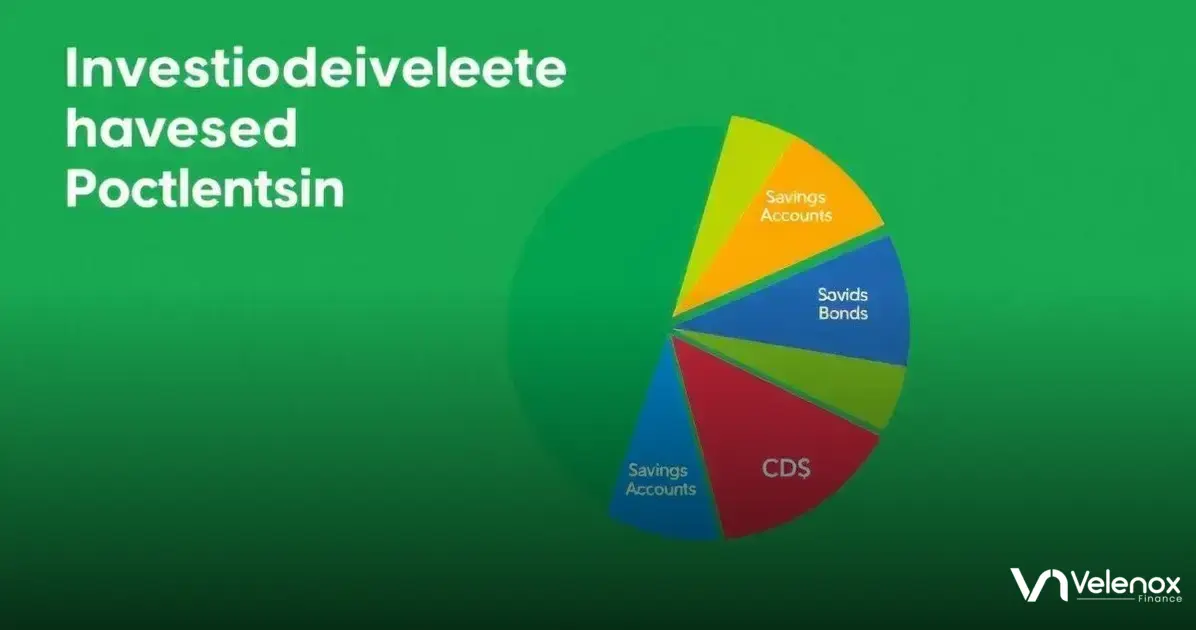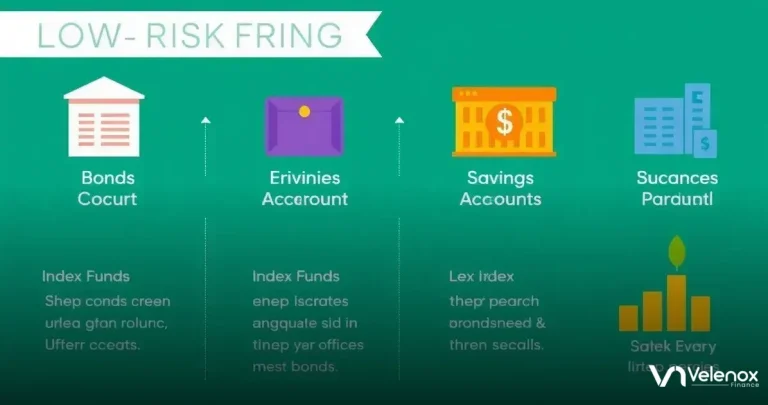Low-risk investments are ideal for individuals who want to secure their savings while still allowing for modest growth.
These options provide a safety net and can help protect your money from unexpected market swings.
By choosing low-risk investments, you can feel confident that your funds will be safe over time, giving you peace of mind.
Common types of low-risk investments include savings accounts, government bonds, and certificates of deposit (CDs).
ADVERTISEMENT
These investments typically offer lower returns compared to high-risk options, but they prioritize safety.
This means it’s easier to plan for your financial future without the stress of significant losses.
Incorporating low-risk investments in your overall portfolio is a smart move.
They can balance out more volatile investments, allowing you to enjoy potential high returns while still having a secure foundation.
This approach promotes better financial health and long-term stability for your savings and investments.
In today’s financial landscape, low-risk investment options are essential for anyone looking to secure their future without compromising their savings.
These safe choices allow you to minimize risks while growing your portfolio.
Understanding Low-Risk Investment Options
Low-risk investment options are choices that help you grow your money without taking big chances.
These types of investments are perfect for people who want to avoid losing their hard-earned cash.
By putting your money in safe places, you can sleep well at night, knowing your savings are protected.
Examples of low-risk investments include savings accounts, government bonds, and certificates of deposit (CDs).
These options usually offer lower returns than riskier investments, but they also come with less worry.
It’s important to choose investments that match your comfort level when it comes to risk.
Understanding low-risk investment options is key to building a secure financial future.
By carefully assessing your choices and learning about different options, you can make smart decisions that benefit you over time.
Remember that even small gains add up, leading to steady growth of your savings.
Benefits of Choosing Low-Risk Investments
Choosing low-risk investments has many advantages that can help you achieve your financial goals.
One major benefit is the peace of mind that comes from knowing your money is safe.
With low-risk options, you don’t have to worry as much about losing your investment, allowing you to focus on growing your savings over time.
Another benefit of low-risk investments is the steady, predictable returns they offer.
While they may not make you rich overnight, these investments can generate consistent growth.
This makes them perfect for long-term planning, such as saving for retirement or a child’s education.
Finally, low-risk investments can act as a foundation for a balanced portfolio.
They provide stability during market ups and downs, helping to reduce overall risk.
By including low-risk options in your investment strategy, you can create a safer financial environment for yourself and your family.
Types of Low-Risk Investment Options
There are several types of low-risk investment options that can help you grow your money safely.
One popular choice is a savings account, which offers a secure place to keep your funds.
Banks provide interest on the money you deposit, allowing it to grow over time while remaining easily accessible.
Another great option is government bonds. When you buy a bond, you are lending money to the government.
In return, they pay you interest over time. Since governments are generally reliable borrowers, bonds are considered safe investments that offer steady returns.
Certificates of deposit (CDs) are also a smart low-risk choice.
A CD is a time deposit where you agree to keep your money in the bank for a set period. In exchange, you get a higher interest rate than a standard savings account.
This makes CDs a sound option for those looking to earn more while keeping their money secure.
How to Start Low-Risk Investing

Starting low-risk investing is easier than you might think. First, you should set clear financial goals.
Ask yourself what you want to achieve with your investments, whether it’s saving for a big purchase or building a nest egg for the future.
Knowing your goals will help you choose the right low-risk options for your needs.
Next, it’s essential to do your homework. Research various low-risk investment options, like savings accounts, government bonds, and CDs.
Each option has different rules and benefits, so understanding them can help you make informed decisions.
You can also consult a financial advisor if you need expert advice.
Finally, start small and gradually increase your investment as you become more comfortable.
Many low-risk investments require a small initial amount, so you can get started without a huge commitment.
As you gain confidence and learn more about investing, you can adjust your strategy to meet your growing financial needs.
Comparing Low-Risk Investments
When comparing low-risk investments, it’s important to understand how each option works.
For instance, savings accounts provide easy access to cash and offer a small interest rate. They are great for short-term savings or emergency funds.
However, the interest rate may not fully keep up with inflation over time.
On the other hand, government bonds typically offer better returns than savings accounts.
They are considered safe since they are backed by the government.
When you invest in bonds, you agree to lend money for a set period in exchange for regular interest payments.
This can be a suitable option for those looking for steady income.
Certificates of deposit (CDs) also play a key role in low-risk investment comparisons. CDs often provide higher interest rates than savings accounts and bonds.
However, money invested in CDs is locked in for a specific time, making them less flexible.
It’s vital to weigh these factors carefully to choose the best option for your financial goals.
Common Myths About Low-Risk Investments
Many people believe that low-risk investments don’t offer good returns, but this is a common myth.
While it’s true that the returns may not be as high as riskier options, low-risk investments can provide consistent and steady growth over time.
For many investors, this reliability is more valuable than chasing high returns.
Another misconception is that low-risk investing is only for people who are afraid of taking risks.
In reality, many savvy investors include low-risk options in their portfolios as a way to balance their overall investment strategy.
By combining low-risk and high-risk investments, you can protect your assets while still having opportunities for growth.
Lastly, some people think that low-risk investments are boring. However, these options can be an important part of a smart financial plan.
They not only provide stability, but also help ensure that your money is working for you in the long run.
Embracing low-risk investments can lead to stress-free financial growth.
Tips for Successful Low-Risk Investing
To succeed in low-risk investing, it’s important to have a clear plan. Start by setting specific financial goals that outline what you want to achieve.
This could be saving for a vacation, a home, or retirement.
When you know your goals, you can choose the right low-risk options that will help you reach them over time.
Another key tip is to diversify your investments. Even within low-risk options, spreading your money across different investments can help protect you.
For example, instead of putting all your money into a single savings account or bond, consider a mix of options like CDs and government bonds.
This way, you reduce risk and increase the potential for steady growth.
Finally, be patient and stay informed. Low-risk investments can take time to grow, but sticking with your plan is essential.
Keep learning about different investment choices and be aware of changes in the market.
By reviewing your investments regularly, you can make smart adjustments that keep you on track toward your financial goals.
Portfolio Diversification with Low-Risk Options

Portfolio diversification is an important strategy for managing risk, especially when using low-risk investment options.
By spreading your money across different types of investments, you can reduce the chances of losing money.
This means not putting all your eggs in one basket, which is a smart way to protect your savings.
Incorporating a mix of low-risk investments can enhance your portfolio.
For instance, you can combine savings accounts, government bonds, and certificates of deposit (CDs).
Each of these options offers unique benefits and safety, allowing your portfolio to remain stable even when some investments may not perform as well.
Moreover, regularly reviewing your diversified portfolio is essential. Life changes and market conditions can affect your financial goals.
By assessing your investments, you can make adjustments to your mix of low-risk options and ensure you stay on track to grow your wealth safely.
Low-Risk Investments
What are low-risk investments?
Low-risk investments are financial options that offer safety and stability, typically providing consistent returns.
Why should I consider low-risk investments?
Low-risk investments help protect your savings from market volatility and economic downturns.
What are some examples of low-risk investments?
Examples include government bonds and savings accounts, which typically provide reliable returns.
How do low-risk investments contribute to financial goals?
They allow you to focus on long-term financial goals without unnecessary worry.
What traits are essential for successful investing?
Patience and discipline are essential traits for successful investing.
How can I gradually build my wealth with low-risk investments?
By regularly contributing to low-risk investment options, you can gradually build your wealth.





